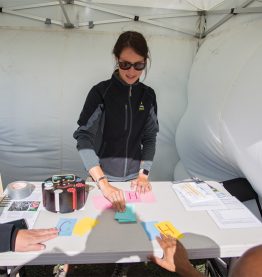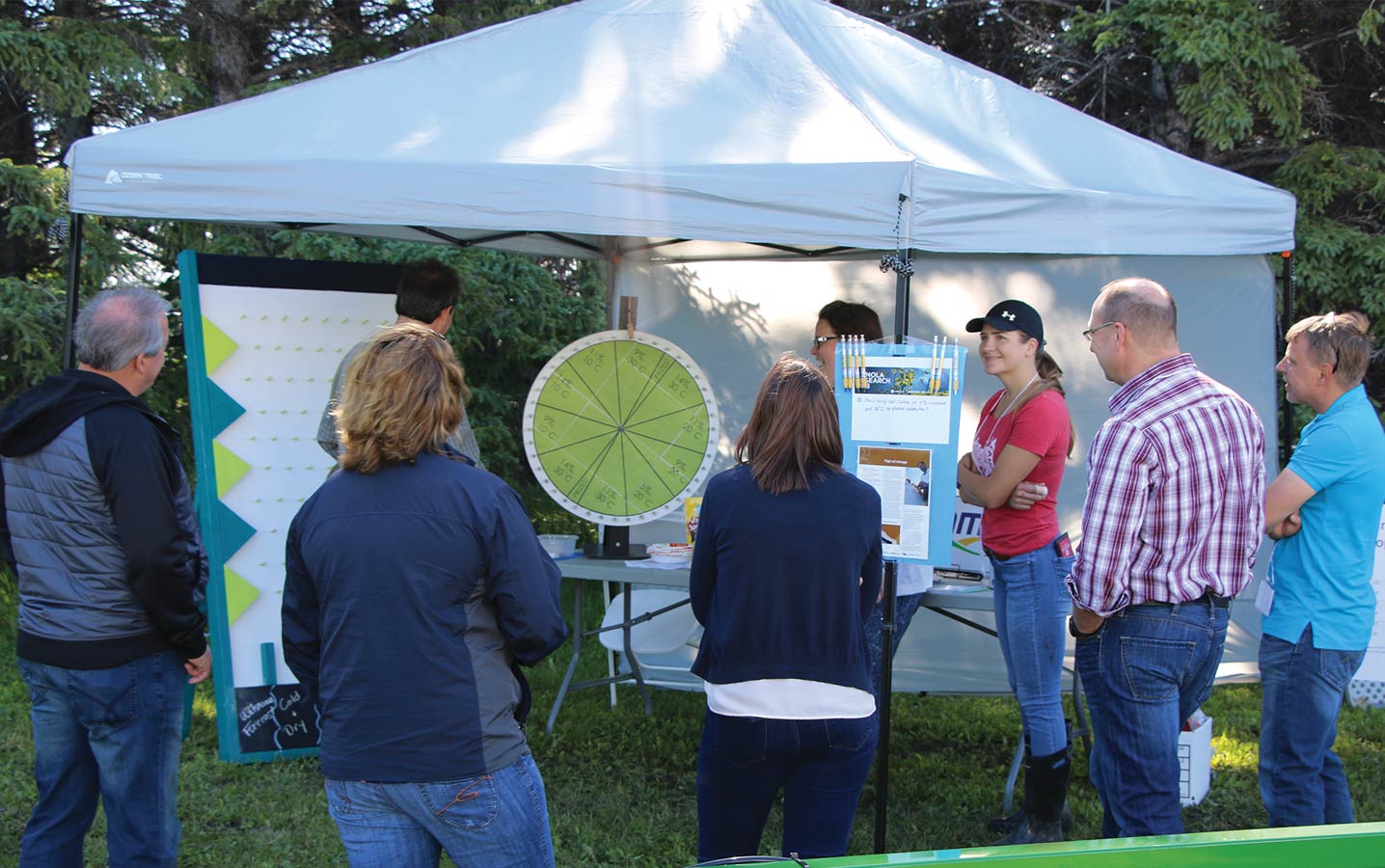A Hub of activity at canolaPALOOZA
This summer, at research stations in Manitoba, Saskatchewan and Alberta, over 1,000 canola growers, researchers, agronomists and industry partners took part in the interactive field-day carnival that is canolaPALOOZA, now in its third year. As the coordinator of the Canola Research Hub, this gave me the opportunity once again to meet some of the website’s audience and talk to the subject-matter experts about results and recommendations included in our content.
WHEEL OF STORAGE CONDITIONS
At the Storage Management station of the Manitoba event, Lorne Grieger, an engineer with Prairie Agricultural Machinery Institute (PAMI), spoke about the importance of making the right management decisions at the right time when it comes to long-term storage in grain bins.
“The key things to understand with storage management of canola is your moisture conditions and your temperature inside your bin,” says Grieger. “If you need to dry the seed down to keep it at a safe moisture content level for the storage temperature, you have to make a decision to either turn fans on or off to get the condition you’re looking for inside the canola.”
Joy Agnew, also with PAMI, was on site with an innovative conversation starter around factors that affect the grain when it’s in the bin. The two-part activity involved spinning a wheel to determine the scenario for conditions of the grain in the bin, and then dropping a chip into a pegboard to get the air conditions. This opened up discussion on the best options for managing proper storage under the given parameters.
“If the grain is tough or warm, you’re probably going to run your fan no matter what,” says Agnew. “But if it’s close to what you want both temperature- and moisture-wise, it matters what the outside air is because that’s going to affect the grain itself.”
A research project led by Agnew entitled “Determining best practices for summer storage of canola in Western Canada” was undertaken in 2014 and continued in 2016. These studies filled a knowledge gap on what to do with canola stored through winter and into the summer. Canola is increasingly stored this long due in part to increased bin capacity and year-round market demand. With the temperature extremes experienced on the Prairies, the definition of best management practices is crucial to minimizing the risk of spoilage.
In 2014, very dry canola (six per cent moisture content) was stored in commercial-sized grain bins and treated with three different management practices – aeration, turning or leaving it alone. Prior to the study period, the seed had been stored over the winter and frozen. Agnew found that, despite a large temperature differential (28ºC) within the bin, temperature and moisture of the grain remained fairly stable throughout the summer.
The 2016 objective was to determine if higher moisture content (nine per cent) canola should be managed differently for storage into the summer months. In both years of study, both turning and aeration resulted in unstable conditions for a short period of time that may have resulted in condensation in the grain, and ultimately potential loss of revenue.
The best option found was to monitor the temperature profile, watching for any rapid increases regardless of actual values, and to have a plan to move the canola if any issue arises. You can find summaries and reports of both years of this study on the Canola Research Hub (canolaresearch.ca) under Harvest Management.
BLACKLEG BLACKJACK
Blackleg, the most widespread fungal disease of canola in Western Canada, poses a serious production threat. Although resistant cultivars are widely used to control this disease, canola’s genetic resistance is breaking
down, new blackleg races are emerging, and market restrictions and economic losses are increasing concerns to growers.

Clint Jurke, agronomy director for the Canola Council of Canada (CCC), was one of the presenters at the canolaPALOOZA Blackleg Management station. “We are trying to develop a better understanding for how blackleg can cause yield loss and our options for managing that disease in canola,” says Jurke. “Some new things have happened in the last year, and this is our opportunity to share that with the canola industry, especially farmers and agronomists.”
One significant step forward was the recent canola industry decision to incorporate new blackleg-resistance labels on canola varieties. These labels will provide greater detail than the current Resistant ‘R’ and Moderately Resistant ‘MR’ labels that are based on field ratings of blackleg compared to the susceptible variety, Westar.
“Because this pathogen is one that changes really quickly,” Jurke says, “it has a really complicated genetic ammunition with which to overcome resistance genes. We’re finding out that as blackleg continues to evolve, we do need to have a more complicated system to stay one step ahead of it.”
At canolaPALOOZA, this complicated system was illustrated at the Blackleg Blackjack table. Players were dealt cards bearing the new labelling codes A, B, C, D, E1, E2, F, G, H or X, which correspond to major resistance genes present in canola varieties. The ‘house’ was then dealt cards to indicate a number of avriulence genes that the blackleg pathogen would be carrying in the given scenario. If the player was holding enough of the right resistance cards, they could successfully manage the disease and win the hand.
Dilantha Fernando, researcher at the University of Manitoba Department of Plant Science, and Gary Peng, research scientist with Agriculture and Agri-Food Canada, also took part in this year’s blackleg stations. Fernando and Peng concluded that diversity is key to blackleg resistance in the four-year Canola Agronomic Research Program (CARP) study titled “Blackleg Resistant Stewardship: Improving our management of host resistance”.
The objective of this study was to understand pathogens on-farm and by regions and identify strategies to reduce resistance breakdown. The findings showed that the avirulence gene (AVrLM3) that corresponds with the most commonly used resistance gene (Rlm3) was actually among the rarest of genes to be found in all tested blackleg samples. However, two others (AvrLM5 and AvrLm7) were detected in more than 85 per cent of the pathogen population. The new labelling system will provide growers the tools they need to equip their crops to combat exactly what they’re up against.
You can find summaries and reports of Drs. Fernando and Peng’s research, and other completed and in-progress studies, on the Hub (canolaresearch.ca) under Integrated Pest Management by entering the keyword ‘blackleg.’





